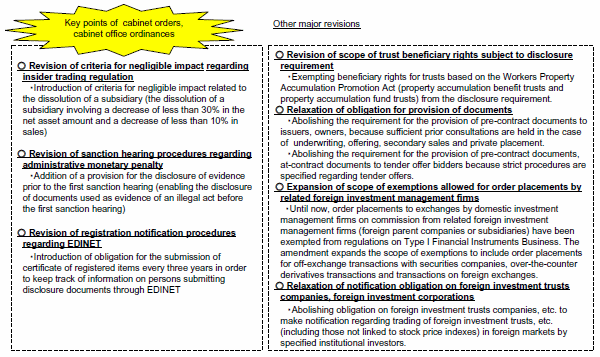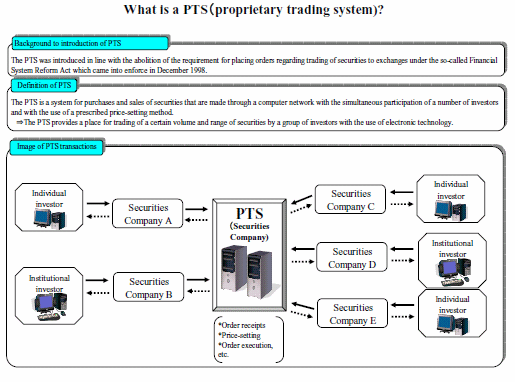[Explanations of Laws and Regulations]
Cabinet Orders and Cabinet Office Ordinances Concerning the 2008 Amendment of the Financial Instruments and Exchange Act
1. Introduction
Following the enactment and promulgation on June 6 and on June 13 of 2008, respectively, of the Act for the Amendment of the Financial Instruments and Exchange Act (hereinafter referred to as the “Amendment Act”), which includes provisions for institutional improvements necessary for strengthening Japan’s financial and capital markets, the government decided, at a cabinet meeting on December 2, 2008, the Cabinet Order Concerning the Establishment and Revision of Relevant Cabinet Orders Related to the Enforcement of the Act for the Amendment of the Financial Instruments and Exchange Act and promulgated it on December 5.
It was stipulated that the Amendment Act must enter into force on a date within six months from the date of its promulgation (June 13, 2008) that is prescribed by a relevant Cabinet Order, and December 12, 2008 was determined as the date of its entry into force. (The Cabinet Order that prescribes the date of the entry into force was also decided at the cabinet meeting held on December 2, 2008 and promulgated on December 5.)
Cabinet Office Ordinances and other regulations concerning the Amendment Act also entered into force on December 12, 2008.
It should be noted that the portions of the Amendment Act that concern the reform of the firewall regulations and the establishment of control systems for preventing the conflicts of interest must enter into force within one year from the promulgation of this act (by June 12, 2009).
The key points of the revisions of the Cabinet Orders and Cabinet Office Ordinances that entered into force at this time are as follows:
2. Establishment of new markets intended for professional investors
The Amendment Act puts in place an institutional framework for new markets intended for professional investors (specified investors), and instead of imposing the current disclosure rules requiring the availability of information for public view as a prerequisite on issuers which are to be listed on such new markets, it allows such issuers to use simplified procedures for the provision and publication of information.
The Cabinet Orders and Cabinet Office Ordinances that entered into force at this time include the following provisions for institutional improvements:
(i) specifying the details of the obligation for the notification of solicitation activities and transactions related to financial instruments intended for professional investors as well as the details of the restriction on the resale of such financial instruments that is aimed at preventing resale to ordinary investors
(ii) specifying that the contents of information regarding securities and issuers and the method of information provision should be based on rules set by exchanges.
(iii) specifying that preliminary investigations regarding the conformance with the criteria for listing or delisting of stocks should be included in the scope of the self-regulatory activities that exchanges may consign to entities other than self-regulatory organizations
(iv) establishing rules regarding the joint establishment of an exchange by a Japanese exchange and a foreign exchange (the scope of entities that can hold a stake of between 20% and 50% in an exchange that is a subsidiary of a Japanese exchange in terms of voting rights has been expanded to include foreign exchanges)
3. Diversification of exchange-traded funds (ETFs)
From the viewpoint of improving convenience for users, the Amendment Act expands the scope of products exchangeable with ETFs to include assets convertible into cash, in addition to securities, as a measure to diversify ETFs.
The Cabinet Orders and Cabinet Office Ordinances that entered into force at this time have added commodities spots and commodity futures, including gold, to the scope of the products in which ETFs may invest mainly, and added commodities listed on commodity exchanges to the scope of products exchangeable with ETFs.
4. Expansion of scope of businesses permitted to Banking and Insurance Groups
From the viewpoint of further promoting corporate rehabilitation (regional rehabilitation), the Amendment Act has expanded the scope of exemptions to the restriction on the ownership of shareholder voting rights by banking and insurance groups (the scope of exemption, which was previously limited to venture businesses, has been expanded to include companies engaging in business rehabilitation efforts) and removed the ban that prohibits banks and insurance companies from directly engaging in the investment advisory business and conducting emissions trading.
The Cabinet Orders and Cabinet Office Ordinances that entered into force at this time provide for the following measures:
(1) Specifying the scope of companies exempted from the restriction on the ownership of shareholder voting rights by banking and insurance groups
(i) Companies that have received approval for the management reform plan under the Law concerning to the Promotion of New Business Activities by Small and Medium Enterprises are specified as companies engaging in business rehabilitation efforts.
(ii) The upper limit on the corporate age of venture businesses exempted from the restriction has been raised from less than five years from their establishment to less than 10 years.
(2) Allowing subsidiaries and sister companies of banks and insurance companies to engage in the Islamic finance business, which should be deemed to be effectively equivalent to the provision of credit
(3) Allowing banks and insurance companies to directly conduct emissions trading.
5. Revision of administrative monetary penalty system
The Amendment Act has raised the amount of the administrative monetary penalties and expanded the scope of entities subject to the administrative monetary penalty system.
Regarding the provision that imposes the penalties in cases where an illegal act has been committed in the account of “persons with close relations or special relations with the offender” by regarding the act as having been committed in the offender’s own account, the Cabinet Orders and Cabinet Office Ordinances that entered into force at this time have specified subsidiaries and family members as the “persons with close relations or special relations with the offender.”
6. Other major revisions
Other major revisions include:
(i) the establishment of the standards for the exemption of some transactions related to the dissolution of a subsidiary by a listed company (those related to the dissolution of a subsidiary that involves a decrease of less than 30% in the net asset amount and a decrease of less than 10% in sales) from the insider trading rule due to their negligible impact;
(ii) the addition of a provision for the disclosure of evidence prior to the first sanction hearing as part of the revision of procedures for the sanction hearing regarding the imposition of administrative monetary penalties;
(iii) relaxation of the obligation for issuers to provide documents; and
(iv) expansion of the scope of transactions eligible for the exemption allowed for order placements by related foreign investment companies.
Implementation of administrative monetary penalty system in relation to reporting of large shareholding
Following the amendment of the Financial Instruments and Exchange Act (hereinafter referred to as the FIEA), persons who fail to submit a large shareholding report and/or who make a false statement in the report have been subject to the administrative monetary penalty since December 12, 2008.
Cases subject to the penalty are:
(Case 1) Failure to submit a large shareholding report or a report on a change in a large shareholding. (Article 172-7, the amended FIEA)
(Case 2) Submitting (1) a large shareholding report, (2) a report on a change in a large shareholding, or (3) an amendment report of (1) or (2) that contains any false statement on important matters and/or lacks a statement on important matters that should be stated.
(Article 172-8, the amended FIEA)
The amount of administrative monetary penalty is to be 1/100,000 of the market capitalization of the issuer of the stock that is subject to the requirement for the reporting of a large shareholding.
In Case 1 above, if the person who has failed to submit the required report notifies the Securities and Exchange Surveillance Commission (SESC) of the failure prior to either of (1) the issuance of an administrative order for the submission of a report or (2) the commencement of an inspection, he/she may be eligible for the halving of the administrative monetary penalty under a new rule for the reduction of the penalty. (Article185-7, Paragraph 12 of the amended FIEA)
* Click here
 for a link to the format and the reporting procedures regarding the penalty reduction rule (the web site of the Securities and Exchange Surveillance Committee).
for a link to the format and the reporting procedures regarding the penalty reduction rule (the web site of the Securities and Exchange Surveillance Committee).
There is also a new rule under which a repeat offender may face an additional administrative monetary penalty. (Article 185-7, Paragraph 13 of the amended FIEA)
The following are examples of failure to meet the requirement for the submission of a report regarding a large shareholding.
(Example 1) A person who had acquired more than 5% of the total number of a listed company’s outstanding shares failed to submit a large shareholding report by the due date and submitted it after the due date.
(Example 2) A person who had submitted a large shareholding report purchased an additional 1% or more of the total number of outstanding shares but failed to submit a report on the change in the large shareholding by the due date and submitted it after the due date.
(Example 3) A person who had submitted a large shareholding report failed to submit a report on a change in the large shareholding by the due date when the number of joint holders increased, leading to a rise of 1% or more in the share ownership ratio, and submitted the change report after the due date.
The FSA invited opinions from the public regarding the revision of the Comprehensive Guidelines for Supervision of Financial Instruments Business Operators (draft) from September 19 to October 20, 2008, following the amendment of the Financial Instruments and Exchange Act (which entered into force on December 12, 2008). On December 2, it published the results of the public comment procedure and revised the guidelines. The revised guidelines have been applicable since December 12.
The key points of the revision are as follows:
1. Treatment of securities intended for specified investors
(1) In light of the introduction of the restriction on the sales and purchases of securities intended for specified investors (professional investors) under Article 40-4 of the Financial Instruments and Exchange Act, the establishment of procedures and systems for the prevention of sales and purchases of such securities by ordinary investors in cases where a financial instruments business operator handles such securities has been added as a point of attention when supervisors consider whether to authorize the business operator to engage in the PTS (proprietary trading system) business.
(2) In light of the introduction of the obligation for notification regarding securities intended for specified investors under Article 40-5 of the Financial Instruments and Exchange Act, whether a financial institution identifies the actual state of notifications it must make when it handles such securities, and whether it implements corrective measures when necessary have been added as supervisory viewpoints regarding financial instruments business operators’ systems for solicitation and explanations.
2. Instructions for representation of investment reports regarding investment trust assets
Following the addition of rights related to physical commodities and commodity futures transactions to the category of “specified assets” that are major investment vehicles for investment trusts under Article 3(ix) and (x) of the Ordinance for Enforcement of Act on Securities Investment Trust and Securities Investment Corporations, specific instructions for the representation of investment reports concerning investment trusts investing in such rights were added to the guidelines for supervision.
This section provides information regarding the hot topics of the moment, selected from questions and answers given at the Minister's press conferences, etc. If you wish to find out more, we invite you to visit the "Press Conferences" section of the FSA website.
[Opening Remarks by Minister Nakagawa]
Regarding the financial situation, following today’s enactment of the revised Act on Special Measures for Strengthening Financial Functions, we would like to put the new act into force as soon as possible. We plan to put it into force next week, although the deadline for the enforcement is two months from the enactment according to the text of the act. Furthermore, the quota for funds for capital injection will be raised by 10 trillion yen from the current 2 trillion yen in the fiscal 2008 budget to 12 trillion yen. In addition, although we have already initiated crisis management measures to facilitate fund-raising, we have concluded that the purchase of CP will be necessary, so, as the Prime Minister explained earlier, we intend to allocate 3 trillion yen for the purchase of CP in the second supplementary budget and another 3 trillion yen in the initial budget for fiscal 2009, compared with the 66 billion yen or so currently allocated for that purpose. Also, we have started procedures for the purchase of CP as a measure to secure liquidity toward the end of the year. We hope that the designated financial institutions will take appropriate action in this respect. We also hope that the Bank of Japan will take additional measures to secure sufficient liquidity amid the severe year-end fund-raising situation for companies. Next, regarding measures to facilitate fund-raising at the end of the calendar and fiscal years, as the Prime Minister said earlier, 4 trillion of the 6- trillion-yen quota for credit guarantee still remains unused, so I strongly hope that these funds will be used. During the few hours when I attended today’s plenary Diet session, some lawmakers came to me and talked about a credit crunch for SMEs in their constituencies. I will instruct the Financial Services Agency to invite financial industry representatives for something like a briefing session - I would like to attend the session if possible - as soon as possible to remind them of the importance of the credit guarantee scheme and of the need to provide loans properly. Also, I intend to convene a meeting with the Directors- General of Local Finance Bureaus next Monday and give them an instruction regarding measures based on the revised Act on Special Measures for Strengthening Financial Functions and year-end support measures.
(Extract from the press conference on December 12, 2008)
[Opening Remarks by Minister Nakagawa]
Meanwhile, the revised Act on Special Measures for Strengthening Financial Functions is promulgated today and will be put into force tomorrow. This act was enacted last Friday, and it was specified that the act had to be put into force within two months. However, as we implemented the necessary procedures without any delay and at an extraordinary speed, we have managed to put it into force so that the capital injection scheme can be utilized starting in mid-December. Yesterday, we took steps to ensure that the purpose of this act is fully communicated to all relevant parties across the country. According to media reports, I understand that there are some financial institutions that are eager to utilize this scheme. As the approval of capital injection into a financial institution made as a result of screening is a proof of the institution’s soundness, I hope that this will be actively used so that small and medium-size enterprises (SMEs) across the country can receive necessary funds.
(Extract from the press conference on December 16, 2008)
Q:I would like to ask you about the Act on Special Measures for Strengthening Financial Functions. I hear that you plan to meet with financial industry representatives tomorrow and explain the purpose of this act directly to them. I suppose that among financial institutions, there is still a strong reluctance to receive public funds under the capital injection scheme. Could you tell me how you intend to encourage financial institutions to use this scheme so as to make effective use of the 12 trillion yen allocated for it?
A: As I said earlier, financial institutions in some regions are hoping to use this in order to provide funds to their regions, according a media report I read yesterday. While there may be some such financial institutions in some regions, a media report today said that a financial institution in Hokkaido has denied a need for capital injection. Although there may be various speculations, this scheme is intended not to support financial institutions but to ensure that they properly exercise their functions for the benefit of SMEs and local economies. So, if financial institutions that are sound enough to qualify for capital injection refuse to receive public funds, I suppose they could even be criticized. Regardless of how strongly we may urge them to do so, financial institutions that avoid applying for capital injection from the government may invite doubt about their soundness - it may be too much to say this - as capital injection will not be approved for troubled financial institutions this time, although applying for capital injection only to be rejected would also be problematic. Borrowers are complaining about the severe situation across the country while financial institutions are speaking of their own pains. In such a situation, financial institutions have a social responsibility to strengthen their capital bases and meet the fund needs of SMEs in their regions in the year-end period.
On Sunday, I talked with various SME managers in my constituency and they still have complaints about the financing situation. At a committee meeting yesterday, such complaints were also discussed. As there are still complaints about credit guarantee associations and financial institutions, I hope that by using the capital injection scheme, financial institutions will provide funds to companies that need them and that both borrower companies and financial institutions will contribute to successful business, which they need to achieve before performing social responsibility.
[Extract from the press conference on December 16, 2008]
[Information]
The FSA has started an E-mail Information Service. If you register your e-mail address on the Subscribe Page of the FSA website, we will notify you by e-mail once on each day when new information is posted on our website. For details, please access Subscribing to E-mail Information Service of the FSA website.
Site Map
- Press Releases & Public RelationsPage list Open
- Press Releases
- Press Conferences
- Official Statements
- FSA Weekly Review & ACCESS FSA
- Speeches
- For Financial Users
- Others
- Archives
- Laws & RegulationsPage list Open
- Name of Laws and Regulations(PDF)

- Recent Changes (Legislation, Ordinances, Guidelines)
- Guidelines
- Financial Instruments and Exchange Act
- Financial Monitoring Policy
- Public Comment
- No-Action Letter System
- Procedures concerning Foreign Account Management Institutions













